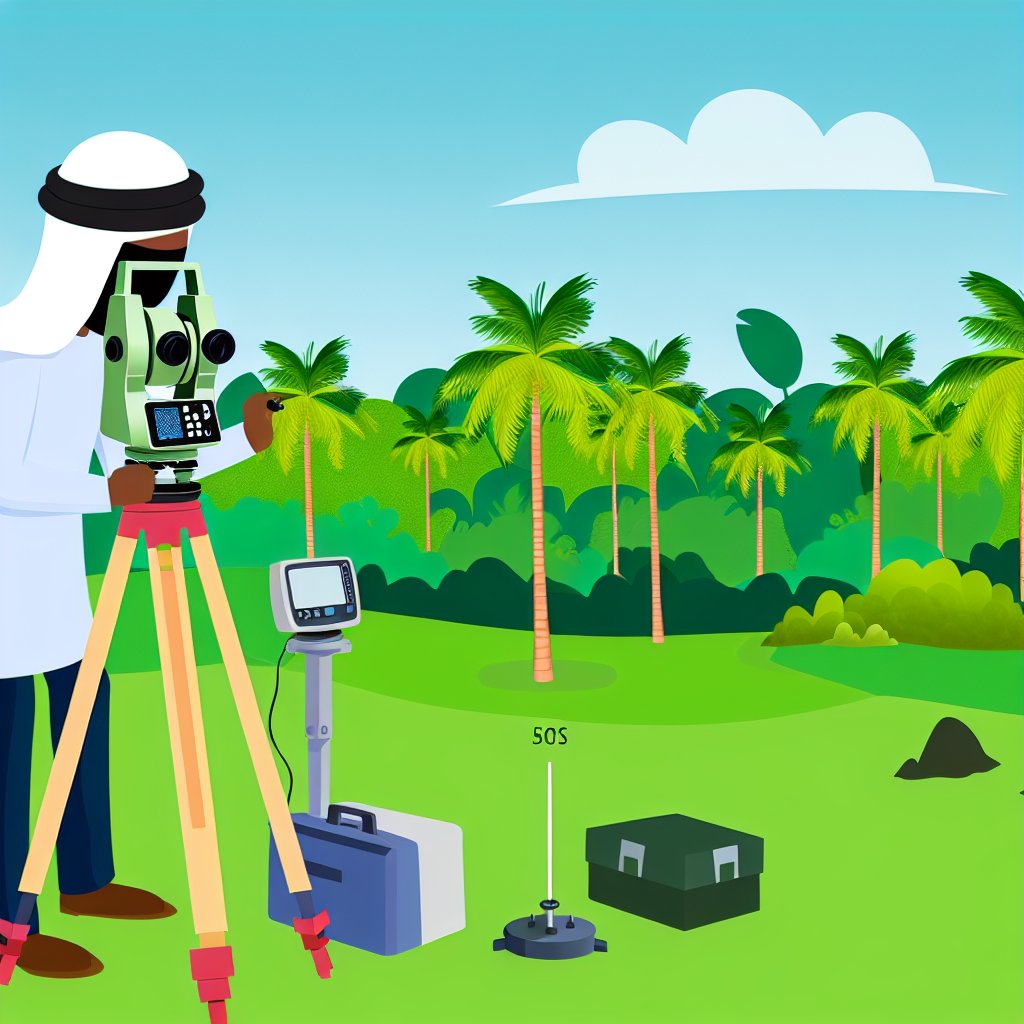Introduction:
Land surveying involves measuring and mapping of land.
Geoinformatics focuses on analyzing geographical data.
Importance of Land Surveying and Geoinformatics:
These fields play a crucial role in urban planning.
They are essential for construction, natural resource management, and environmental conservation.
Overview of Land Surveying:
Land surveying is the process of measuring and mapping the positions of points on the Earth’s surface.
It has been used for centuries to establish boundaries, define property lines, and create maps.
Accurate land surveying is crucial for various industries like construction, real estate, and infrastructure development.
Definition of land surveying:
Land surveying is the technique, profession, and science of accurately determining the terrestrial or three-dimensional positions of points and the distances and angles between them.
It involves a combination of mathematics, physics, and geography to create accurate measurements of land parcels.
Historical background of land surveying:
Land surveying dates back to ancient civilizations like the Egyptians, Greeks, and Romans.
It played a significant role in shaping land ownership, property rights, and urban planning throughout history.
Technology advancements, such as GPS and GIS, have revolutionized the field of land surveying.
Importance of accurate land surveying:
Accurate land surveying ensures proper land use planning and development.
It helps prevent land disputes, encroachments, and legal issues related to property boundaries.
Land surveying also plays a vital role in maintaining environmental conservation and resource management.
Role of Land Surveyors:
Land surveyors are responsible for measuring properties, boundaries, and topographical features to determine land size and boundaries accurately.
They use a variety of tools such as GPS, total stations, and drones to collect data.
To excel in this field, land surveyors need strong mathematical skills, attention to detail, problem-solving abilities, and the ability to work both independently and in a team.
They must also have good communication skills to interact with clients and colleagues effectively.
There are several techniques used in land surveying, including GPS surveying, aerial surveying, hydrographic surveying, and cadastral surveying.
Each technique utilizes different tools such as GPS receivers, drones, total stations, and sonar equipment to collect accurate data.
Land surveyors play a crucial role in determining property boundaries and land sizes accurately.
To succeed in this profession, individuals must possess a unique set of skills, including strong mathematical abilities, attention to detail, problem-solving skills, and effective communication.
Additionally, knowledge of various land surveying techniques and tools is essential for professionals in this field.
Find Out More: Internship Opportunities for Mechatronics Students
Geoinformatics Overview
Geoinformatics is a field that involves the use of technology to gather, analyze, and interpret geographical information.
It combines aspects of geography, information science, and data management to create visual representations of spatial data.
Definition of Geoinformatics
Geoinformatics, also known as geographic information systems (GIS), refers to the collection, storage, analysis, and visualization of spatial data.
It enables professionals to make informed decisions based on geographical information.
Relation to Land Surveying
Geoinformatics plays a crucial role in land surveying by providing accurate spatial data.
This data helps surveyors create maps and conduct land surveys.
It allows surveyors to analyze and interpret geographic information efficiently.
Applications of Geoinformatics
Geoinformatics is utilized across various industries, each benefiting from its capabilities.
Urban Planning
Geoinformatics is used to analyze and plan urban areas.
This includes infrastructure development, transportation networks, and land use planning.
Environmental Management
Geoinformatics helps monitor environmental changes such as deforestation and climate change.
It does this by analyzing spatial data.
Natural Resource Management
Geoinformatics is utilized in managing natural resources like water, minerals, and forests.
This is achieved by mapping their spatial distribution and availability.
Agriculture
Geoinformatics aids in precision agriculture by optimizing crop yields.
Transform Your Career with Expert Guidance
Get personalized mentorship consulting that’s tailored to your unique path. Our expert advice is actionable and exclusive.
Get StartedIt helps monitor soil conditions and analyze weather patterns.
Emergency Response
Geoinformatics assists in disaster management by mapping affected areas.
It coordinates rescue efforts and provides real-time information to emergency responders.
Archaeology
Geoinformatics is used to map archaeological sites and analyze ancient landscapes.
It helps preserve cultural heritage by recording and visualizing spatial data.
Geoinformatics is a versatile field that plays a vital role in various industries.
Industries such as urban planning, environmental management, agriculture, and emergency response benefit from its applications.
By harnessing the power of spatial data, professionals can make informed decisions.
They can effectively solve complex problems.
Gain More Insights: Practical Skills Needed for Automobile Engineering in Nigeria
Job prospects for land surveyors and geoinformatics professionals
Land surveyors and geoinformatics professionals have a wide range of job opportunities in various industries.
They play a crucial role in ensuring accurate information related to land mapping, geographical data, and spatial analysis.
Construction industry:
Land surveyors are essential in the construction industry for conducting land surveys, preparing topographic maps, and providing accurate measurements for construction projects.
Real estate sector:
In the real estate sector, land surveyors play a pivotal role in determining property boundaries, identifying land ownership, and conducting land evaluations for property transactions.
Urban planning and development:
Urban planners rely on geoinformatics professionals to analyze and interpret geographical data to make informed decisions about land use, infrastructure development, and environmental conservation.
Environmental management:
Geoinformatics specialists are in demand in the field of environmental management to assess land conditions, monitor natural resources, and create conservation strategies based on spatial data analysis.
Government agencies:
Government agencies hire land surveyors and geoinformatics professionals to gather geospatial information, create digital maps, and support decision-making processes related to city planning, disaster management, and resource allocation.
Potential for advancement in these fields
Land surveying and geoinformatics offer excellent opportunities for career advancement.
Professionals in these fields can explore various paths to enhance their skills, expand their knowledge, and take on more challenging roles.
Specialization:
As technology evolves, professionals can specialize in advanced geoinformatics tools, such as Geographic Information Systems (GIS), Remote Sensing, and Global Positioning Systems (GPS), to become experts in their field.
Continuing education:
To stay competitive, land surveyors and geoinformatics professionals can pursue additional certifications, attend workshops, and enroll in further education programs to stay updated on industry trends and advancements.
Leadership roles:
Experienced professionals have the opportunity to transition into leadership positions where they can manage teams, oversee projects, and make strategic decisions to drive innovation and growth in the field.
Research and academia:
Some professionals choose to enter the research and academic fields, where they can contribute to advancing knowledge in land surveying and geoinformatics through research studies, publications, and teaching roles.
The career opportunities in land surveying and geoinformatics are diverse and promising, with ample room for growth, specialization, and development in various industries and sectors.
See Related Content: Agricultural Engineering and Climate Change Solutions
Educational Requirements:
When it comes to pursuing a career in land surveying and geoinformatics, there are specific educational requirements that individuals need to meet.
These requirements are essential for obtaining the necessary knowledge and skills to succeed in this field.
Academic Qualifications:
- A Bachelor’s degree in surveying, geomatics, or a related field is typically required for entry-level positions in land surveying and geoinformatics.
- Courses in mathematics, geography, computer science, and geospatial technologies are important components of the academic curriculum.
- Graduate degrees, such as a Master’s or Ph.D., may be necessary for advanced positions in research, academia, or specialized areas.
Certifications and Licenses:
- Professional certifications, such as the Licensed Surveyor or GIS Professional designation, may be required by some employers or state regulations.
- Licensing requirements vary by state and country, so it is important to research the specific regulations in the area where you plan to work.
- Continuing education and professional development are crucial for maintaining certifications and licenses, as well as staying current with industry trends.
Importance of Continuing Education:
- Continuing education allows professionals in land surveying and geoinformatics to expand their knowledge and skills, keeping them competitive in the job market.
- Professional development opportunities, such as workshops, conferences, and online courses, provide valuable learning experiences and networking opportunities.
- Staying updated on the latest technologies and methods in the field is essential for delivering accurate and efficient surveying and geospatial solutions.
Find Out More: Government Policies on Systems Engineering in Nigeria

Challenges in the Field:
Land surveyors and geoinformatics professionals often face common challenges that can hinder their work.
These challenges may include inaccurate data, complex terrain, and difficult weather conditions.
In order to overcome these obstacles, professionals must be equipped with the right skills and tools.
It is crucial for surveyors to stay updated with the latest technology and advancements in the field.
By embracing new tools and techniques, professionals can improve the accuracy and efficiency of their work.
Continuous learning and training are essential for staying competitive in the fast-paced world of land surveying and geoinformatics.
Networking with other professionals in the industry can also provide valuable insights and support in overcoming challenges.
Collaboration with other experts in related fields can help land surveyors tackle complex projects more effectively.
Building strong relationships with clients and stakeholders is key to understanding their needs and delivering quality results.
By addressing challenges head-on and being proactive in seeking solutions, professionals can enhance their reputation and success in the field.
The importance of staying updated with the latest technology and advancements in land surveying and geoinformatics cannot be overstated.
Salary and Career Growth:
Land surveyors and geoinformatics professionals can expect a competitive salary range.
On average, their salaries can range from $50,000 to $90,000 per year, depending on factors such as experience, location, and employer.
Both land surveying and geoinformatics offer abundant opportunities for career advancement and growth.
With the increasing demand for professionals in these fields, individuals can progress from entry-level roles to senior positions with higher responsibilities and pay.
Several factors play a role in determining the salary and career progression of land surveyors and geoinformatics professionals.
Experience, education, specialized skills, certifications, geographic location, and the type of employer can all impact earning potential and advancement opportunities.
Professionals who continuously update their skills and knowledge through continuing education and training tend to have better prospects for salary increases and career growth.
Importance of Land Surveying and Geoinformatics
Land surveying and geoinformatics play vital roles in various industries. They gather, analyze, and interpret spatial data efficiently.
This blog post highlighted key responsibilities, skills, and technologies involved in these fields. It showcased the diverse career opportunities available.
Individuals interested in pursuing a career in land surveying and geoinformatics will find this overview valuable. It provides insights into the industry.
Understanding the importance of these fields shapes the future of modern society. Aspiring professionals can contribute to sustainable development.
The integration of land surveying and geoinformatics in decision-making projects demonstrates their significance. They advance our understanding of the world around us.
Additional Resources
USM Recognizes 25th Graduating Class of Hydrographic Science …




